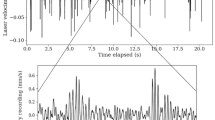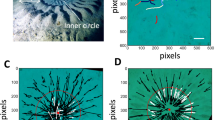Abstract
Several classes of earthworm behavior were studied in a three-dimensional, semi-natural habitat. Descriptions of burrowing, foraging, feeding, and mating behavior were obtained. In addition, the worms were exposed to light, air, and vibratory stimulation while in their burrows. Light and intermittent vibration consistently elicited responses while air was an ineffective stimulus.
A second study investigated the effects of a light-dark cycle and the time of day upon the amount of burrowing by the earthworm. The light cycle did not affect the distance burrowed, but time of day did have a significant effect upon the amount of burrowing activity.
Similar content being viewed by others
References
BHATTI, H. K. 1962. Experimental study of burrowing activities of earthworms. Agric. Pakist., 13, 779–794.
DARWIN, C. R. 1896. The formation of vegetable mould through the action of earthworm. New York: Appleton & Co.
EVANS, A. C. 1947. A method for studying burrowing activities of earthworms. Annual Magazine of Natural Histo., 14, 643–650.
GRANT, W. C. 1956. An ecological study of the peregrine earthworm Pheretima hupeinsi. in the Eastern United States. Ecolo., 37, 648–658.
KHALAF El-DUWEINI, A., & GHABBOUR, S. I. 1964. Observations on the burrowing activities of Allolohophora caliginosa f. trapazoides. Bulletin of the zoological Society of Egy., 19, 60–63.
RATNER, S. C. 1967. Annelids and learning: A critical review. In W. C. Corning & S. C. Ratner (Eds.), Chemistry of learning: Invertebrate researc. New York: Plenum Press. Pp. 391–406.
RATNER, S. C., & GARDNER, L. E. 1968. Behavior of earthworms. In A. W. Stokes (Ed), Animal behavior in laboratory and fiel. San Francisco: Freeman. Pp. 53–56.
WINER, B. J. 1962. Statistical principles in experimental desig. New York: McGraw Hill.
Author information
Authors and Affiliations
Additional information
This research was supported by Research Grant GB-917 from the National Science Foundation to the second author. The authors are grateful to Stanley Smith and Maureen Hattle who served as research assistants in this project.
Rights and permissions
About this article
Cite this article
Gardner, L.E., Ratner, S.C. In-Burrow Behavior of Earthworms. Psychol Rec 20, 387–394 (1970). https://doi.org/10.1007/BF03393957
Published:
Issue Date:
DOI: https://doi.org/10.1007/BF03393957




